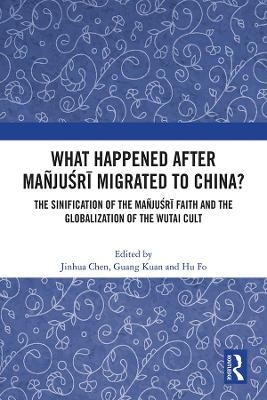
What Happened After Mañjuśrī Migrated to China?
Routledge (Verlag)
978-1-032-07350-7 (ISBN)
The chapters in this book explore the transcultural, multi-ethnic, and cross-regional contexts and connections between the Buddhāvataṃsaka-sūtra, Mount Wutai and the veneration of Mañjuśrī that contributed to the establishment and successive transformations of the cult centered on Mount Wutai – and reduplications elsewhere. The contributions reflect on the literature, architecture, iconography, medicine, society, philosophy and several other aspects of the Wutai cult and its significant influence across several Asian cultures, such as Chinese, Japanese, Tibetan, Mongolian and Korean.
This book is a significant new contribution to the study of the Wutai cult, and will be a great resource for academics, researchers, and advanced students of Religion, Philosophy, History, Architecture, Literature and Art.
The chapters in this book were originally published in the journal Studies in Chinese Religions.
Jinhua Chen 陳金華, Fellow of Royal Society of Canada, Professor at the University of British Columbia and a visiting professor at several universities, including Tokyo University (2003–04), Stanford (2012) and Capital Normal University (2019–20). He has published extensively on state-church relationships, monastic biographical literature, sacred sites, relic veneration, Buddhism and technology. Guang Kuan 寬廣 is Research Fellow in Chinese Buddhism at King’s College, London. His principal research interests lie in the history and texts of Chinese Buddhism, with a particular expertise and interest in translating classical Chinese Buddhist and historical texts. His current study is focused on Ming Buddhist history, particularly on an internationally well-known Buddhist pilgrimage centre (Mount Wutai). Hu Fo 佛護 is Associate Director of the the Wutai Research Institute for Eastern Buddhist Culture 五臺山東方佛教文化研究院, Shanxi, China. His main research interest is the cross-cultural transmission of the Wutai cult.
Foreword The Transmission of Wutai Cult from South Asia to China 1. A chemical ‘explosion’ triggered by an encounter between Indian and Chinese medical sciences: another look at the significances of the Sinhalese Monk Śākyamitra’s (567?– 668+ ) visit at Mount Wutai in 667 2. Fazang’s theory of zhenru 真如 (Skt. tathatā) and zhongxing 種姓 (Skt. gotra): with a focus on the influence of the Ratnagotravibhāga 3. Gathering medicines among the cypress: the relationship between healing and place in the earliest records of Mount Wutai The Spread of the Wutai Cult in China: Center and Margins 4. A study on a stone lantern from Dongzhang village in medieval China 5. Northern Wei Wutaishan: an outside view of centres and peripheries 6. How the Mount Wutai cult stimulated the development of Chinese Chan in southern China at Qingliang monasteries 7. The way of the Nine Palaces (jiugong dao 九宮道): a lay Buddhist movement The Wutai Cult in Japan 8. Moving monks and mountains: Chōgen and the cults of Gyōki, Mañjuśrī, and Wutai 9. Decentering Mañjuśrī: some aspects of Mañjuśrī’s cult in medieval Japan 10. Representations of the Wutai Mountains in classical Japanese literature The Wutai Cult in Tibet, Mongolia, Khotan and Korea 11. Tibeto- Mongol Buddhist architecture and iconography on Wutaishan, seventeenth to early twentieth centuries 12. A visit of Christian missionaries at Mount Wutai: Mongol Buddhism from a cross- cultural perspective 13. The Mañjuśrī cult in Khotan 14. Ennin’s (793– 864) Sillan connections on his journey to Mt. Wutai: a fresh look at Ennin’s travel record
| Erscheinungsdatum | 31.01.2024 |
|---|---|
| Verlagsort | London |
| Sprache | englisch |
| Maße | 174 x 246 mm |
| Gewicht | 453 g |
| Themenwelt | Geisteswissenschaften ► Geschichte ► Regional- / Ländergeschichte |
| Geisteswissenschaften ► Religion / Theologie ► Buddhismus | |
| ISBN-10 | 1-032-07350-0 / 1032073500 |
| ISBN-13 | 978-1-032-07350-7 / 9781032073507 |
| Zustand | Neuware |
| Informationen gemäß Produktsicherheitsverordnung (GPSR) | |
| Haben Sie eine Frage zum Produkt? |


